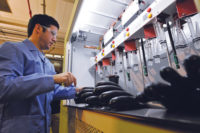Establish a safety program
Implement work practice improvements that eliminate moisture and other hazards from the manufacturing process. Engineering out every possible hazard can be difficult; the next best line of defense is personal protective apparel.
You want a material that will not ignite or allow molten metal to penetrate to the skin. The concept of adherence is equally important; the best materials allow molten metal to roll off quickly, without any sticking.
Many companies use a tiered system, Outfit workers based on their proximity to the hazard. Workers in critical areas, 10 feet or closer to the molten metal, typically wear three or more layers of clothing: an aluminized outer garment, FR-treated cotton “greens” underneath, and an inherently-FR t-shirt or long johns at the base. Workers between 10 and 20 feet can usually forego the aluminized outer layer, and workers beyond 20 feet may be able to wear lighter weight protective apparel.
Create a well-defined plan for visitors and other off-site personnel. Visitors should keep a distance from the hazard and don different colored PPE than regular staff.
Employ the ASTM F955-07 standard
Test the molten metal resistance of a particular material according to the ASTM F955-07 Standard. Roughly two pounds of liquid metal are poured onto a sample swatch of material. Two temperature sensors are positioned under the material, one at the point of impact, and one 10 cm below. The sensors measure the amount of heat transfer that would be passed through to the wearer’s skin. Data estimates the amount of time before a second degree burn.
The ASTM standard also calls for the material to be evaluated based on charring, shrinkage, adherence, and the level of perforation. Tests performed by an accredited lab can evaluate, compare and select materials best suited for specific hazards. Your clothing provider should be able to provide these test results upon request as well as guidance as to material selection.
Utilize fabric weight
Based on recent ASTM F955-07 testing conducted by the University of Alabama and sponsored by Magid Glove & Safety, a specific set of FR-treated cotton fabric samples weighing 9 oz./yd² or heavier did not experience any perforation when exposed to a molten splash. Meanwhile, 7 oz. or lighter-weight fabric samples of the same FR-treated cotton experienced some level of perforation.
Don’t infer this particular 9 oz. FR-treated cotton fabric presents an impenetrable barrier. Heat transferred would result in at least second degree burns. Still, a 2 oz. per square yard of fabric was the difference between no direct skin contact and full perforation by molten metal.
Heavier weight materials offer greater protection, and multiple layers of materials provide significantly greater levels of protection.
Select different materials for different metals
Aluminum has a relatively low melting point of around 1400° F, making it more sticky and gelatinous than other molten metals. FR-treated cotton tends to perform poorly against molten aluminum — the metal sticks to the material more readily. Choose clothing made from an inherently FR material with few creases, seams or other places for liquid metal to stick. Manufacturers will usually specify whether a garment is designed to protect against molten aluminum.
Iron and steel each have melting points approaching 3000° F, and lower viscosity than aluminum. Clothing protecting from molten iron and steel needs to be sturdy to withstand quick, hot burns. Layering heavier weight materials is a solution.
Protect against heat stress
Jobs requiring the thickest, bulkiest protection are the jobs that create the most danger of heat stress-related illness. Acclimatize workers to hot environments. Start new workers with short shifts; gradually increase their workload as they adapt to the environment.
Set up cooling centers for workers operating near heat sources, with predetermined “on/off” schedules. A worker operating near a blast furnace might spend 20 minutes at work, 10 minutes resting and hydrating in the cooling center, 20 minutes back at work, etc.
Minimize heat stress by choosing the right protective clothing. If protection on the back of the legs isn’t needed, aluminized chaps provide some ventilation. Some manufacturers work with clients to create custom clothing for specific applications.



